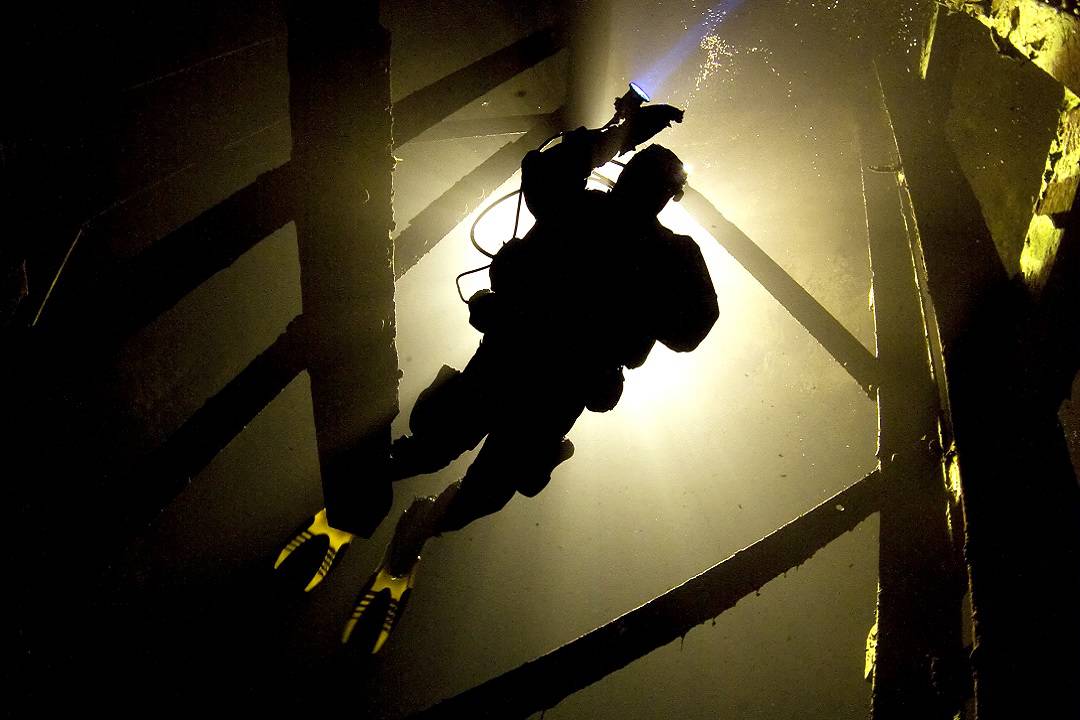“The most difficult part is getting in and out of the water,” said Douglas Goergens, owner of West End Diving Center in Bridgeton, Missouri. “Once you’re in, you’re an astronaut. You’re weightless. You get the feeling of soaring.”
It’s that sense of otherworldly adventure that has attracted people to exploring the underwater world via scuba diving for decades. And it can be a wonderful, lifelong sport. Kids ages 10 and older can get certified with a parent, and local dive shops say they regularly have couples in their 80s coming in.
Diving in the Midwest is “greener and colder” than in international destinations, but it has a lot to offer, says Valerie Elliott, who has owned Y-kiki Divers with her husband, Ken, since 2005. They stumbled into the sport almost on a whim: With the talk the impending millennium and rumored Y2K computer bug, the couple and a group of friends decided to spend the occasion somewhere warm. Why not Belize and scuba diving? Valerie eventually left her job with the St. Louis Business Journal to teach classes and travel the world on dive trips.
Y-kiki Divers, certifies about 350 people a year, in addition to organizing local and international scuba trips. “There’s a pretty big community of people [locally], who like to travel, especially in the winter months, somewhere tropical, get a few dives in,” said Elliott, noting recent trips to Grenada and St. Martin.
While many people use their certification to check out the pristine coral reefs, it’s not a necessity. Missouri is home to a number of notable dive sites, including Bonne Terre Mine, the world’s largest subterranean lake and No. 1 on USA Today’s America’s Best Underwater Attractions list. Here’s a look at five great locations within a short drive of St. Louis where you can blow bubbles.
Bonne Terre Mine
Bonne Terre, Mo.

It’s said to be the world’s largest freshwater scuba venue, attracting 15,000 divers a year from all over the world. The mine’s never-failing 100 feet of visibility is hard to find, and the constant temperature of 65 degrees makes diving here a year-round activity.
Bonne Terre offers group outings of up to 12 people with a safety diver and 40- to 60-foot depth. You’ll explore three dive trails per trip, and the mine has more than 50 trails overall. Since Bonne Terre is an abandoned lead mine, there are tons of interesting things to see, including ore cars, machine shops, dynamite cases and even a locomotive.
For those who aren’t ready to jump in fins-first, Bonne Terre Mine offers boat and walking tours to 30,000 people a year for $27 (adults) and $20 (kids).
Mermet Springs
Vienna, Ill.

A spring-fed rock quarry in Southern Illinois, Mermet Springs is the training ground for Y-kiki Divers open-water certification students. The quarry’s owner, Glen Faith, bought a Boeing 727 from the producers of the movie U.S. Marshals, which was filmed nearby, for $1 and sunk it along with a school bus, Cessna planes, a semi-truck and an anchored boat.
With a 100-foot wall and on-site camping, Mermet Springs gets very popular in the summer. It offers visibility ranging from 15 feet to more than 60 feet and lies within a 3.5-hour drive of downtown St. Louis.
Y-kiki’s Elliott says she likes the schools of large bluegill, spoonbills and giant catfish — a couple of which are albinos. These prehistoric throwbacks have huge mouths and are known to grow larger than 5 feet in length. All are friendly, almost tame.
Haigh Quarry
Kanakee, Ill.

A former limestone mining site, owner Jim Haigh purchased the property in 1978 and decided to let nature take its course by unplugging the pumps. Three years later, the quarry was filled with water. It became a scuba dive facility in 1992. Today, the quarry features an artifact park with six underwater sites where divers learn about the study of underwater archaeology.
Divers interested in being educated in underwater archaeology techniques can learn from a certified instructor; Haigh Quarry also allows divers to learn other specialty techniques, including night diving, search and recovery diving, and underwater videography.
Bull Shoals Lake
Bull Shoals, Ark.

An artificial lake in the Ozarks, Bull Shoals features 200-foot rock walls and 1,050 miles of shoreline to explore. More than 12 mapped dive sites around the lake include structures such as caverns, underwater forests, long gravel points, sunken farm implements, boats, a destroyer escort and more.
The water in Bull Shoals Lake is clear and offers good visibility. In addition, the lake doesn’t freeze, so you can dive year-round with an average winter water temperature in the 50s; average summer temperature is in the 80s. Fish friends in this body of water include walleye, crappie, catfish, gar, carp and drum.
Roubidoux Spring Cave
Waynesville, Mo.

Roubidoux Spring Cave in Waynesville is often mentioned as one of the best cave diving springs in the country. While it is open to explore for free, all divers turned spelunkers must be cave-certified and must check in and present their certification card to the 911 Emergency Communications Center, which is on top of the hill adjacent to the fire station.
Once inside the cave, underwater explorers will discover a seemingly endless limestone passage that snakes under the spring to a staggering depth of 270 feet. The water is cold, and it can be a challenge to see once the silt is stirred up, but lucky divers may spot a blind cave crawfish or blind fish.
Kimberley Donoghue is a regular contributor to Terrain Magazine. She has a blue bike named Jesse, a dog named Oliver and a penchant for homemade seitan after a session at the climbing gym.


[…] For more of the Midwest’s top dive sites, visit terrain-mag.com/midwest-scuba-sites. […]